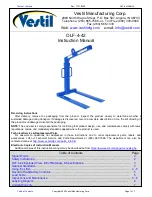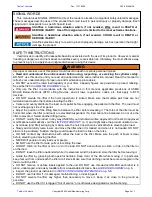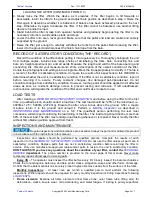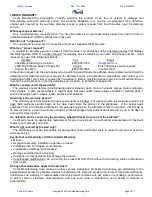
Rev. 11/11/2020
OLF-4 MANUAL
Copyright 2020 Vestil Manufacturing Corp. Page 4 of 7
NATIONAL STANDARDS
OLF-series products are Below-the-Hook lifting (BTH) devices designed to facilitate handling of palletized
loads. American National Standard ASME B30.20 (the “Standard”), which can be purchased online at
https://www.asme.org/codes-standards/find-codes-standards/b30-20-hook-lifting-devices
provides
inspection, testing, maintenance, and operation instructions for users of BTH devices. Acquire a copy of the
Standard. Apply all mandatory provisions of Chapter 20-1:
Structural and Mechanical Lifting Devices
.
Contact local occupational safety and health specialists to determine whether there are laws, ordinances,
codes, etc. (“authorities”) in addition to the Standard that apply to BTH pallet handlers in the location where
the handler will be used. If content in this manual conflicts with provisions in authorities or the Standard,
apply the provisions from the authorities or Standard. Contact
USING THE LIFTER
This lifter is a below-the-hook lifting device, design category B (used for loads and variations which are
severe and not accurately defined), service class 1 (20,001 to 100,000 load cycles). It should only be
operated by qualified personnel. ASME B30.20 defines
qualified person
as “a person who, by the
possession of a recognized degree in an applicable field or certificate of professional standing, or who, by
extensive knowledge, training, and experience, has successfully demonstrated the ability to solve or resolve
problems relating to the subject matter at hand.” Qualified persons include designated persons, trainees
under the direct supervision of a designated person, maintenance personnel, test personnel, and inspectors.
ADJUSTING THE LIFTER
Height of OLF-series lifters is adjustable. Adjust the height by removing the height adjustment pin (99-
112-057). Pull the inner frame tube up. Align the pin holes in the inner and outer frame tubes; then reinstall
the height adjustment pin.
LOADING THE LIFTER
ONLY lift pallets (closed bottom skids) with this device. Make sure that loads are centered and evenly
distributed on their pallets. Make sure that loads are securely bound to their pallets before lifting them. If
loose items fall off of the pallet while the lift is underway, people could be injured. The center of gravity of the
load also changes if load items fall off of a pallet. Shifting center of gravity could cause the lifter to tip and
the rest of the load could be lost.
1. Attach the hoist hook to the connection
link.
2. Stand behind the lifter. Grasp both
operator handles. Fully insert the forks
into the fork channels of the pallet.
3. Slowly raise the lifter. Check load
balance and stability. The forks should be
level front-to-back and side-to-side. If the
lifter tilts forward or backward, the
position of the lifting bale must be
adjusted. Lower the lifter to the ground.
Then,
a. Remove the bale adjustment pin.
b. Slide the bale along the lifting arm.
Reinstall the pin.
i. Lifter tilts forward (fork tips down):
Shift the bale towards the free end
of the lifting arm.
ii. Lifter tilts backward: Shift the bale
towards the back of the lifting arm.
Minimize swinging! Make sure
that the hoist is centered above
the bale, i.e. hoist chain/rope is
vertical. If the hoist chain/rope is
not vertical, the lifter will swing as
it is elevated.
CONTINUED ON P. 5
A
Height
adjustment pin
Front of
lifting arm
B
Bale
Fork
Operator
handle
Connection
link
Bale adjustment
pin
A
B
Retaining pin







